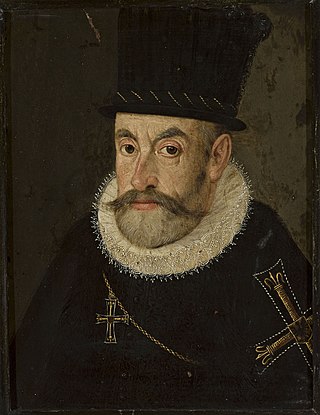Top Qs
Timeline
Chat
Perspective
Maximilian III, Archduke of Austria
Grand Master of the Teutonic Order From Wikipedia, the free encyclopedia
Remove ads
Maximilian III of Austria (12 October 1558 – 2 November 1618), was a member of the House of Habsburg and the Archduke of Further Austria from 1612 until his death. He was also briefly known as Maximilian of Poland during his claim for the Polish throne. After trying and failing to be elected as King of Poland, he launched the War of the Polish Succession and was defeated by the winner, Sigismund III Vasa. He was also Grand Master of the Teutonic Order.
Remove ads
Biography
Summarize
Perspective


Born in Wiener Neustadt, Maximilian was the fourth son of the Emperor Maximilian II and Maria of Spain. He was a grandson of Anna of Bohemia and Hungary, daughter and heiress of Vladislaus II of Bohemia and Hungary, who himself was the eldest son of Casimir IV of Poland from the Jagiellonian dynasty.
In 1585, Maximilian became the Grand Master of the Teutonic Order; thanks to this he was known by the epithet der Deutschmeister ("the German Master") for much of his later life.[1]
In the 1587 Polish–Lithuanian royal election Maximilian stood as a candidate for the throne of the Polish–Lithuanian Commonwealth, following the death of the previous king, Stephen Báthory. A portion of the Polish nobility supported Maximilian, but the larger faction elected Prince Sigismund of Sweden, grandson of Sigismund I the Old, as Sigismund III Vasa. Maximilian then invaded Poland, starting the War of the Polish Succession (1587–1588). He had considerable support in Poland, but fewer Poles flocked to his army than to that of his rival. In late 1587, he tried and failed to storm Kraków. At Pitschen in Silesia, he met Sigismund's army, commanded by Polish hetman Jan Zamojski. In the Battle of Byczyna (24 January 1588), Maximilian was defeated and captured. He was released a year and half later after the intervention of Pope Sixtus V in the aftermath of the Treaty of Bytom and Będzin. In 1598, he formally renounced his claim to the Polish crown.[2] The inactivity of his brother, Emperor Rudolf II, in this matter contributed to Rudolf's poor reputation.[citation needed]
From 1593 to 1595, Maximilian served as regent for his young cousin, the future Emperor Ferdinand II as Archduke of Inner Austria. In 1595, Maximilian succeeded to the territories of their uncle Ferdinand II, Archduke of Further Austria, including Tyrol, where he proved to be a solid proponent of the Counter-Reformation. He also worked to depose Melchior Khlesl, and to ensure that Ferdinand succeeded as Holy Roman Emperor.
Today, Maximilian is perhaps best remembered for his baroque archducal hat, exhibited in the treasury of the monastery of Klosterneuburg and used for ceremonial purposes as late as 1835.
He died at Vienna in 1618, and is buried in the canopied tomb in Innsbruck Cathedral.
Remove ads
Ancestors
Remove ads
Male-line family tree
Remove ads
References
Wikiwand - on
Seamless Wikipedia browsing. On steroids.
Remove ads


